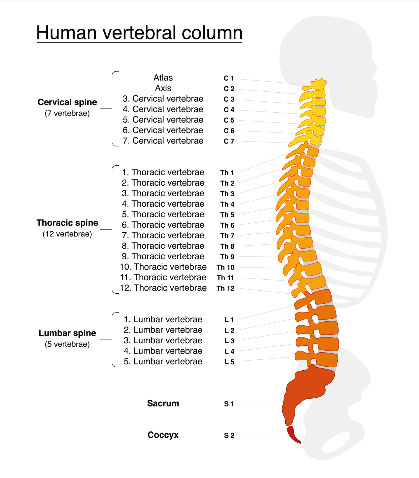The thoracic is located between the cervical (neck) and lumbar (lower back). It consists of twelve vertebrae that attach to the rib cage and twenty-four discs that are inserted between the vertebrae to prevent them from rubbing together. More pain occurs in the cervical and lumbar than the thoracic because the thoracic spine is not as flexible. The main role of the thoracic spine is to keep the back stable and protect the organs (heart and lungs). The nerves that radiate from the thoracic spine area innervate the chest and abdomen.

Common pains located in the thoracic spine may result from lifting heavy objects, having poor posture, muscle strain, herniated discs, thoracic radiculopathy, scoliosis, and osteoarthritis. The best treatment plan for these pains include NSAIDs, ice packs (for throbbing pain) and heating pads (for muscle stiffness and spasms) for 20 minutes four times per day interchangeably, exercise to strengthen the muscles, sessions with a chiropractor for spinal manipulation and massages, and practicing good posture. If you experience constant pressure in the upper portion of your thoracic (T1-T5) that radiates anteriorly (towards the chest), have numbness and tingling sensations, then I recommend that you obtain an EKG (go to your closest ER as soon as possible) to rule out a possible heart attack. Sometimes, it is difficult to distinguish the difference between chest pain and upper thoracic pain. It’s best to assess the pressured pain by having an EKG performed first. If the EKG results are normal, then please follow up with your physician or general practitioner for a thoracic MRI or CT and, based on the results, a referral to a pain management specialist or neurosurgeon.
References:
Furian, P. H. (2019). Vertebral column with names and numbers of the vertebrae – lateral view – fiery colors. Isolated vector illustration on white background. [Diagram].
Louw, A., & Schmidt, S. G. (2015). Chronic pain and the thoracic spine. The Journal of manual & manipulative therapy, 23(3), 162–168. doi:10.1179/2042618615Y.0000000006
